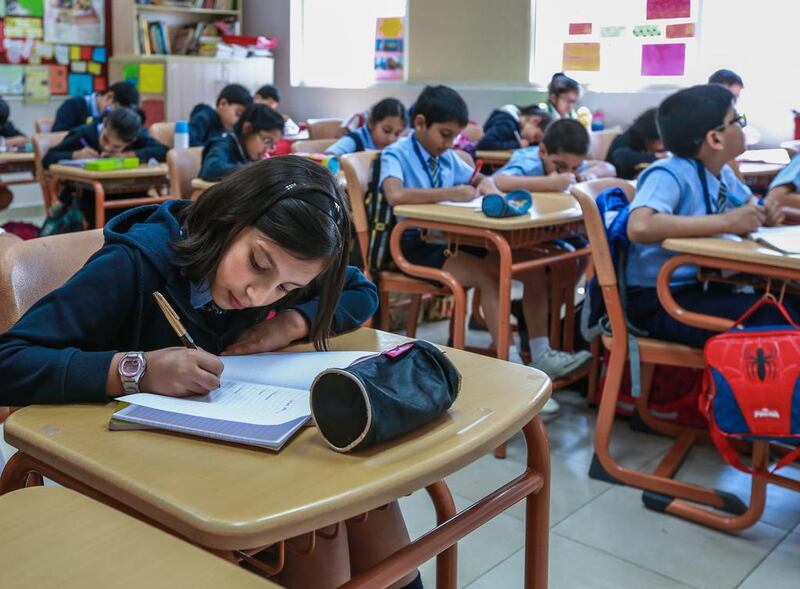DUBAI // The standard of education provided by Indian curriculum schools in the emirate has been significantly improved in the past year, according to a report by the Knowledge and Human Development Authority.
The School Inspections Key Findings 2015-2016 report showed 29 of the 32 Indian schools, with 77,431 pupils, were inspected.
Of those examined two were rated outstanding, three very good, 11 good and 11 acceptable. Just two were found to be weak.
Seven schools improved their rating compared with last year and, of those, three schools moved from good to very good ratings and four improved from acceptable to good.
None of those inspected dropped in their ratings.
“It’s really gratifying to know that all our hard work has paid off and is reflected in the rating,” said Nargish Khambatta, principal of Gems Modern Academy, which, along with the Indian High School, was rated as outstanding for the fifth year in a row. “The findings and recommendations are very succinct and the process was open and transparent.”
Over the past 12 months, the school focused on National Agenda targets and external benchmarking, innovation and incorporating Islamic and UAE culture into subjects.
“We will continue on our path towards the National Agenda as well as improving our provision of Arabic and special-needs education,” Ms Khambatta said.
KHDA initiatives such as What Works, which promote schools sharing their expertise, were key to improvements in Indian schools in general, she said.
“We learn from one another, and if there are schools that do something better than us, or vice-versa, we can share that knowledge.”
From this year all private schools in Dubai are being graded based on the new national School Inspection Framework, which looks at the quality of educational provision on six levels – outstanding, very good, good, acceptable, weak and very weak.
The KHDA report showed Indian schools had huge improvement in the quality of education compared with previous years.
Now 67 per cent of students, or 52,144 pupils attending these schools, are receiving a good or better level of education, an improvement of 22 percentage points since the first inspections by the Dubai School Inspection Bureau (DSIB) in 2009-2010.
But 25,287 children, or a third of the number of Indian school pupils, continued to be taught in schools rated as acceptable or weak, the report said.
The number of good or better judgments for attainment in subjects such as English, maths and science were between 61 and 63 per cent compared with the first round of inspections of 35, 42 and 29 per cent respectively.
Arabic suffered a decline from 13 per cent in 2009-2010 to 7 per cent in the latest inspections.
Indian curriculum schools are also becoming more involved with the National Agenda Parameter, the report found.
That was introduced last year by the regulator to ensure that the emirate’s private schools take part in international and external assessments, other than Trends in International Mathematics and Science Study and the Programme for International Student Assessment.
Fatma Belrehif, executive director of the DSIB, said inspectors had seen Indian schools show significant gains in most aspects of school life including teaching, learning skills, assessment, parental engagement, governance and leadership.
“We want to help schools measure and monitor their progress towards achieving their individual UAE National Agenda targets,” Ms Belrehif said.
“The inspection findings will assist schools in reviewing and meeting these targets while working collaboratively to make progress and help improve the quality of education.”
Six schools improved their provision for pupils with special-education needs and disabilities, while one showed a decline.
Overall, the number of pupils who received a good or better special-needs education had increased to 1,370, or 77 per cent, compared with 774 the year before. Elsewhere, inspectors found pupils’ learning skills were judged to be good or better in 62 per cent of lessons observed.
About two-thirds of lessons observed by inspectors were judged to have good or better teaching.
Provision for pupils’ health and safety was good or better in 85 per cent of schools, and 86 per cent of schools now enjoy good or outstanding links with parents and their communities.
Just over half of the schools’ self-evaluation is good or better and two-thirds of Indian curriculum schools benefit from good or better leadership.
Fatima Martin, principal of Gems’ newly opened Millennium School in Al Khail, which rated as good, said: “We maintain our high level of education by ensuring that the leadership is distributed. This allows greater accountability for pupil achievement and ensures that we are able to secure excellence in detail.”
nhanif@thenational.ae






